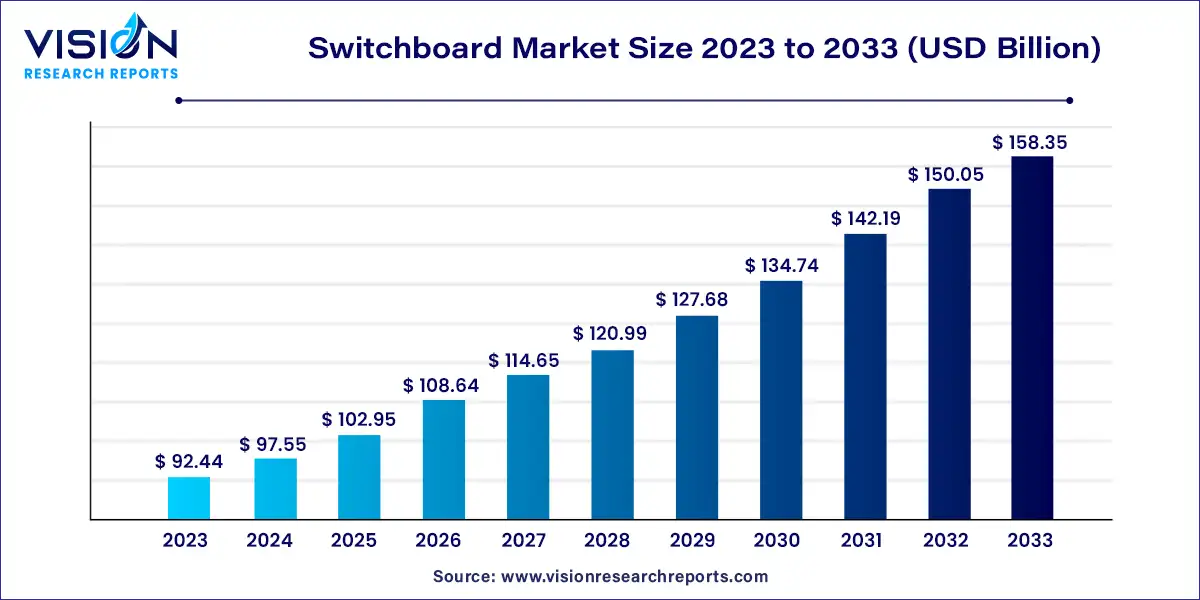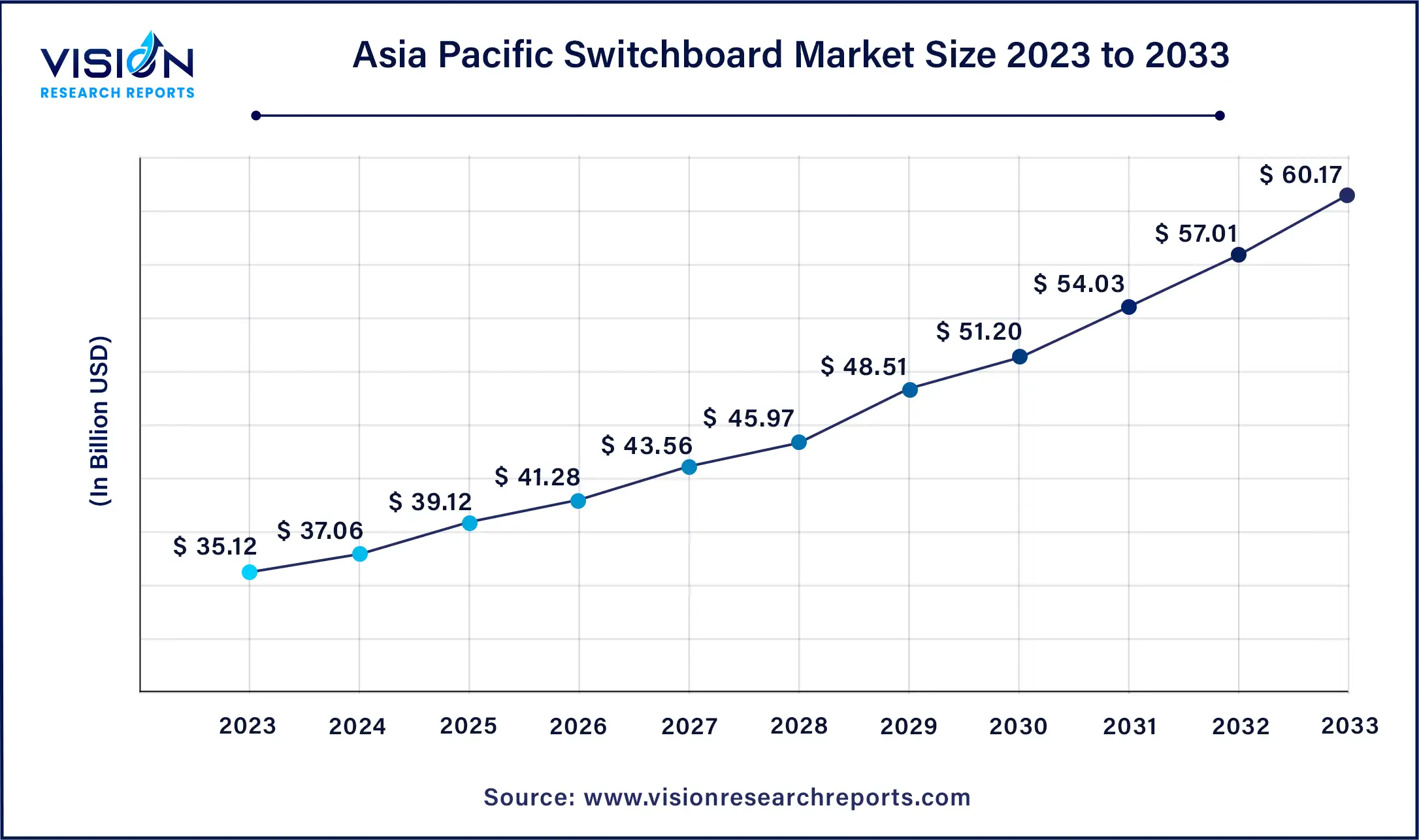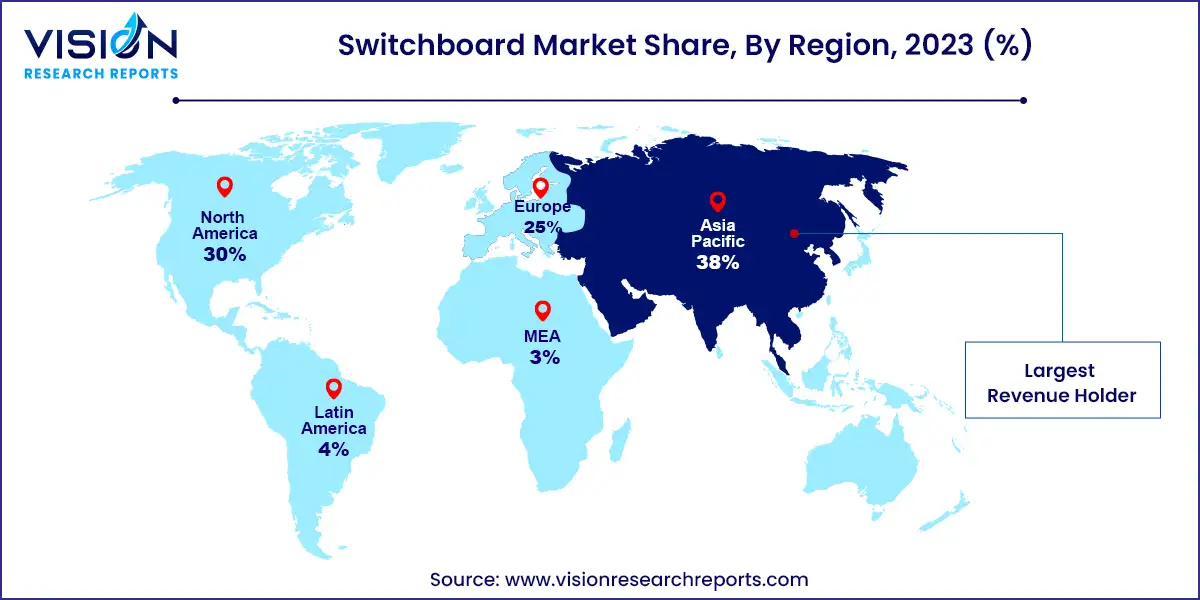The global switchboard market size was estimated at around USD 92.44 billion in 2023 and it is projected to hit around USD 158.35 billion by 2033, growing at a CAGR of 5.53% from 2024 to 2033.

The global switchboard market is poised for significant growth driven by rising demand for electricity, advancements in infrastructure, and the rapid expansion of industrial sectors. Switchboards, essential components in electrical distribution systems, manage the flow of power within various applications, ensuring safety and efficiency.
The switchboard market is experiencing robust growth due to several key factors. Foremost among these is the increasing global demand for electricity, driven by rapid urbanization and industrialization, particularly in developing regions. Additionally, significant advancements in smart grid technology and automation are enhancing the functionality and efficiency of switchboards, making them indispensable in modern electrical distribution systems. Governments' heavy investment in infrastructure projects further propels market expansion, as new residential, commercial, and industrial constructions require advanced electrical distribution solutions. Together, these factors create a dynamic environment fostering substantial growth in the switchboard market.
The Asia Pacific switchboard market size was valued at around USD 35.12 billion in 2023 and is projected to hit around USD 60.17 billion by 2033, growing at a CAGR of 5.53% from 2024 to 2033.

The Asia Pacific region holds the dominant share of the global switchboard market, fueled by a combination of factors reshaping industrial, commercial, and residential sectors. Urbanization has surged in Asia Pacific, driving the construction of new buildings, industrial complexes, and infrastructure projects. As a manufacturing and production hub for industries like electronics, automotive, and manufacturing, the region relies heavily on robust electrical systems, thereby amplifying the demand for reliable switchboards to maintain uninterrupted operations.

Meanwhile, the switchboard market in Europe is experiencing rapid expansion, propelled by a convergence of factors reflecting technological advancements and evolving market needs. Europe is undergoing a widespread digital transformation across various industries, prompting increased adoption of smart technologies. Consequently, there is a heightened demand for advanced switchboards equipped with integrated digital capabilities, which serve as the cornerstone of modern control systems, enhancing efficiency and connectivity. Furthermore, Europe has been a frontrunner in the adoption of renewable energy, particularly wind and solar.
In 2023, the high-voltage segment held the largest share of the market, and it is anticipated to continue its dominance throughout the forecast period. High-voltage switchboards are integral to large-scale industrial and utility applications, managing the distribution of electrical power at high voltages, typically above 1,000 volts. These switchboards are essential in environments where significant amounts of power need to be controlled and distributed, such as power plants, transmission and distribution networks, and large industrial facilities. They are designed to handle higher currents and offer robust safety features, ensuring reliable operation under demanding conditions. The increasing investments in renewable energy projects and the modernization of aging electrical infrastructure in many parts of the world are driving the demand for high-voltage switchboards.
In contrast, low-voltage switchboards operate at voltages up to 1,000 volts and are widely used in residential, commercial, and light industrial applications. They are essential for managing electrical distribution within buildings, including homes, offices, and retail spaces, ensuring that electrical power is safely and efficiently distributed to various devices and appliances. The growing urbanization and the expansion of smart building technologies are significantly boosting the demand for low-voltage switchboards. These switchboards often incorporate advanced features such as smart metering, remote monitoring, and energy management systems, which align with the increasing emphasis on energy efficiency and smart grid integration. Furthermore, the ongoing development of infrastructure projects, particularly in emerging economies, is expected to further propel the growth of the low-voltage switchboard segment
In 2023, the IEC segment held the largest share, a trend expected to persist throughout the projection period. The IEC standard, recognized internationally, provides specifications for the design, performance, and testing of switchboard components and systems. It ensures interoperability and compatibility of switchboards across different countries and facilitates global trade by establishing uniform technical requirements. Manufacturers complying with the IEC standard benefit from broader market access and greater acceptance of their products in regions where IEC standards are adopted, including Europe, Asia-Pacific, and many other parts of the world. The IEC standard covers various aspects of switchboard design, including safety, reliability, and environmental considerations, contributing to the overall quality and functionality of switchboard products.
On the other hand, the ANSI standard, predominantly followed in the United States, outlines guidelines and requirements for switchboard design, construction, and performance. ANSI standards are developed collaboratively by industry stakeholders and regulatory bodies to ensure the safety and reliability of electrical equipment, including switchboards, within the U.S. market. Adherence to ANSI standards is essential for manufacturers seeking to market their switchboard products in the United States and ensures compliance with regulatory requirements set forth by agencies such as the Occupational Safety and Health Administration (OSHA) and the National Electrical Code (NEC). Switchboard products meeting ANSI standards undergo rigorous testing and certification processes to demonstrate their conformity to established performance criteria, instilling confidence in end-users regarding their safety and reliability.
The industrial segment held the dominant share in 2023. Industrial end-users encompass a wide range of industries, including manufacturing, energy, oil and gas, mining, and infrastructure development. In industrial settings, switchboards play a critical role in managing the distribution of electrical power within complex and often high-demand environments. These switchboards are designed to withstand harsh operating conditions, such as temperature fluctuations, moisture, and vibration, while ensuring the reliable and efficient delivery of electricity to machinery, equipment, and production processes. Industrial switchboards are typically customized to meet the specific needs and requirements of different industrial applications, offering features such as fault protection, remote monitoring, and scalability to accommodate future expansions or upgrades.
In the commercial sector, switchboards serve buildings and facilities such as offices, retail stores, educational institutions, healthcare facilities, and entertainment venues. Commercial switchboards are designed to support the electrical distribution needs of diverse environments, ranging from small office buildings to large shopping complexes. They ensure the safe and reliable distribution of power to lighting, heating, ventilation, air conditioning (HVAC), communication systems, and other electrical loads essential for commercial operations. Additionally, commercial switchboards often incorporate advanced features such as energy management systems, smart metering, and integration with building automation and control systems (BACS) to optimize energy efficiency, reduce operating costs, and enhance occupant comfort and safety.
By Type
By Product Standard
By End Users
By Region
Chapter 1. Introduction
1.1. Research Objective
1.2. Scope of the Study
1.3. Definition
Chapter 2. Research Methodology
2.1. Research Approach
2.2. Data Sources
2.3. Assumptions & Limitations
Chapter 3. Executive Summary
3.1. Market Snapshot
Chapter 4. Market Variables and Scope
4.1. Introduction
4.2. Market Classification and Scope
4.3. Industry Value Chain Analysis
4.3.1. Raw Material Procurement Analysis
4.3.2. Sales and Distribution Type Analysis
4.3.3. Downstream Buyer Analysis
Chapter 5. COVID 19 Impact on Switchboard Market
5.1. COVID-19 Landscape: Switchboard Industry Impact
5.2. COVID 19 - Impact Assessment for the Industry
5.3. COVID 19 Impact: Global Major Government Policy
5.4. Market Trends and Opportunities in the COVID-19 Landscape
Chapter 6. Market Dynamics Analysis and Trends
6.1. Market Dynamics
6.1.1. Market Drivers
6.1.2. Market Restraints
6.1.3. Market Opportunities
6.2. Porter’s Five Forces Analysis
6.2.1. Bargaining power of suppliers
6.2.2. Bargaining power of buyers
6.2.3. Threat of substitute
6.2.4. Threat of new entrants
6.2.5. Degree of competition
Chapter 7. Competitive Landscape
7.1.1. Company Market Share/Positioning Analysis
7.1.2. Key Strategies Adopted by Players
7.1.3. Vendor Landscape
7.1.3.1. List of Suppliers
7.1.3.2. List of Buyers
Chapter 8. Global Switchboard Market, By Type
8.1. Switchboard Market, by Type, 2024-2033
8.1.1 Low-Voltage
8.1.1.1. Market Revenue and Forecast (2021-2033)
8.1.2. Middle-Voltage
8.1.2.1. Market Revenue and Forecast (2021-2033)
8.1.3. High-Voltage
8.1.3.1. Market Revenue and Forecast (2021-2033)
Chapter 9. Global Switchboard Market, By Product Standard
9.1. Switchboard Market, by Product Standard, 2024-2033
9.1.1. IEC Standard
9.1.1.1. Market Revenue and Forecast (2021-2033)
9.1.2. ANSI Standard
9.1.2.1. Market Revenue and Forecast (2021-2033)
Chapter 10. Global Switchboard Market, By End Users
10.1. Switchboard Market, by End Users, 2024-2033
10.1.1. Industrial
10.1.1.1. Market Revenue and Forecast (2021-2033)
10.1.2. Residential
10.1.2.1. Market Revenue and Forecast (2021-2033)
10.1.3. Commercial
10.1.3.1. Market Revenue and Forecast (2021-2033)
Chapter 11. Global Switchboard Market, Regional Estimates and Trend Forecast
11.1. North America
11.1.1. Market Revenue and Forecast, by Type (2021-2033)
11.1.2. Market Revenue and Forecast, by Product Standard (2021-2033)
11.1.3. Market Revenue and Forecast, by End Users (2021-2033)
11.1.4. U.S.
11.1.4.1. Market Revenue and Forecast, by Type (2021-2033)
11.1.4.2. Market Revenue and Forecast, by Product Standard (2021-2033)
11.1.4.3. Market Revenue and Forecast, by End Users (2021-2033)
11.1.5. Rest of North America
11.1.5.1. Market Revenue and Forecast, by Type (2021-2033)
11.1.5.2. Market Revenue and Forecast, by Product Standard (2021-2033)
11.1.5.3. Market Revenue and Forecast, by End Users (2021-2033)
11.2. Europe
11.2.1. Market Revenue and Forecast, by Type (2021-2033)
11.2.2. Market Revenue and Forecast, by Product Standard (2021-2033)
11.2.3. Market Revenue and Forecast, by End Users (2021-2033)
11.2.4. UK
11.2.4.1. Market Revenue and Forecast, by Type (2021-2033)
11.2.4.2. Market Revenue and Forecast, by Product Standard (2021-2033)
11.2.4.3. Market Revenue and Forecast, by End Users (2021-2033)
11.2.5. Germany
11.2.5.1. Market Revenue and Forecast, by Type (2021-2033)
11.2.5.2. Market Revenue and Forecast, by Product Standard (2021-2033)
11.2.5.3. Market Revenue and Forecast, by End Users (2021-2033)
11.2.6. France
11.2.6.1. Market Revenue and Forecast, by Type (2021-2033)
11.2.6.2. Market Revenue and Forecast, by Product Standard (2021-2033)
11.2.6.3. Market Revenue and Forecast, by End Users (2021-2033)
11.2.7. Rest of Europe
11.2.7.1. Market Revenue and Forecast, by Type (2021-2033)
11.2.7.2. Market Revenue and Forecast, by Product Standard (2021-2033)
11.2.7.3. Market Revenue and Forecast, by End Users (2021-2033)
11.3. APAC
11.3.1. Market Revenue and Forecast, by Type (2021-2033)
11.3.2. Market Revenue and Forecast, by Product Standard (2021-2033)
11.3.3. Market Revenue and Forecast, by End Users (2021-2033)
11.3.4. India
11.3.4.1. Market Revenue and Forecast, by Type (2021-2033)
11.3.4.2. Market Revenue and Forecast, by Product Standard (2021-2033)
11.3.4.3. Market Revenue and Forecast, by End Users (2021-2033)
11.3.5. China
11.3.5.1. Market Revenue and Forecast, by Type (2021-2033)
11.3.5.2. Market Revenue and Forecast, by Product Standard (2021-2033)
11.3.5.3. Market Revenue and Forecast, by End Users (2021-2033)
11.3.6. Japan
11.3.6.1. Market Revenue and Forecast, by Type (2021-2033)
11.3.6.2. Market Revenue and Forecast, by Product Standard (2021-2033)
11.3.6.3. Market Revenue and Forecast, by End Users (2021-2033)
11.3.7. Rest of APAC
11.3.7.1. Market Revenue and Forecast, by Type (2021-2033)
11.3.7.2. Market Revenue and Forecast, by Product Standard (2021-2033)
11.3.7.3. Market Revenue and Forecast, by End Users (2021-2033)
11.4. MEA
11.4.1. Market Revenue and Forecast, by Type (2021-2033)
11.4.2. Market Revenue and Forecast, by Product Standard (2021-2033)
11.4.3. Market Revenue and Forecast, by End Users (2021-2033)
11.4.4. GCC
11.4.4.1. Market Revenue and Forecast, by Type (2021-2033)
11.4.4.2. Market Revenue and Forecast, by Product Standard (2021-2033)
11.4.4.3. Market Revenue and Forecast, by End Users (2021-2033)
11.4.5. North Africa
11.4.5.1. Market Revenue and Forecast, by Type (2021-2033)
11.4.5.2. Market Revenue and Forecast, by Product Standard (2021-2033)
11.4.5.3. Market Revenue and Forecast, by End Users (2021-2033)
11.4.6. South Africa
11.4.6.1. Market Revenue and Forecast, by Type (2021-2033)
11.4.6.2. Market Revenue and Forecast, by Product Standard (2021-2033)
11.4.6.3. Market Revenue and Forecast, by End Users (2021-2033)
11.4.7. Rest of MEA
11.4.7.1. Market Revenue and Forecast, by Type (2021-2033)
11.4.7.2. Market Revenue and Forecast, by Product Standard (2021-2033)
11.4.7.3. Market Revenue and Forecast, by End Users (2021-2033)
11.5. Latin America
11.5.1. Market Revenue and Forecast, by Type (2021-2033)
11.5.2. Market Revenue and Forecast, by Product Standard (2021-2033)
11.5.3. Market Revenue and Forecast, by End Users (2021-2033)
11.5.4. Brazil
11.5.4.1. Market Revenue and Forecast, by Type (2021-2033)
11.5.4.2. Market Revenue and Forecast, by Product Standard (2021-2033)
11.5.4.3. Market Revenue and Forecast, by End Users (2021-2033)
11.5.5. Rest of LATAM
11.5.5.1. Market Revenue and Forecast, by Type (2021-2033)
11.5.5.2. Market Revenue and Forecast, by Product Standard (2021-2033)
11.5.5.3. Market Revenue and Forecast, by End Users (2021-2033)
Chapter 12. Company Profiles
12.1. ABB Ltd.
12.1.1. Company Overview
12.1.2. Product Offerings
12.1.3. Financial Performance
12.1.4. Recent Initiatives
12.2. Mitsubishi Electric.
12.2.1. Company Overview
12.2.2. Product Offerings
12.2.3. Financial Performance
12.2.4. Recent Initiatives
12.3. Schneider Electric.
12.3.1. Company Overview
12.3.2. Product Offerings
12.3.3. Financial Performance
12.3.4. Recent Initiatives
12.4. Emerson Process Management.
12.4.1. Company Overview
12.4.2. Product Offerings
12.4.3. Financial Performance
12.4.4. Recent Initiatives
12.5. Rockwell Automation.
12.5.1. Company Overview
12.5.2. Product Offerings
12.5.3. Financial Performance
12.5.4. Recent Initiatives
12.6. Eaton
12.6.1. Company Overview
12.6.2. Product Offerings
12.6.3. Financial Performance
12.6.4. Recent Initiatives
12.7. Siemens.
12.7.1. Company Overview
12.7.2. Product Offerings
12.7.3. Financial Performance
12.7.4. Recent Initiatives
12.8. Powerwell
12.8.1. Company Overview
12.8.2. Product Offerings
12.8.3. Financial Performance
12.8.4. Recent Initiatives
12.9. Kounis.
12.9.1. Company Overview
12.9.2. Product Offerings
12.9.3. Financial Performance
12.9.4. Recent Initiatives
12.10. Gedac Electric
12.10.1. Company Overview
12.10.2. Product Offerings
12.10.3. Financial Performance
12.10.4. Recent Initiatives
Chapter 13. Research Methodology
13.1. Primary Research
13.2. Secondary Research
13.3. Assumptions
Chapter 14. Appendix
14.1. About Us
14.2. Glossary of Terms
 Cross-segment Market Size and Analysis for
Mentioned Segments
Cross-segment Market Size and Analysis for
Mentioned Segments
 Additional Company Profiles (Upto 5 With No Cost)
Additional Company Profiles (Upto 5 With No Cost)
 Additional Countries (Apart From Mentioned Countries)
Additional Countries (Apart From Mentioned Countries)
 Country/Region-specific Report
Country/Region-specific Report
 Go To Market Strategy
Go To Market Strategy
 Region Specific Market Dynamics
Region Specific Market Dynamics Region Level Market Share
Region Level Market Share Import Export Analysis
Import Export Analysis Production Analysis
Production Analysis Others
Others